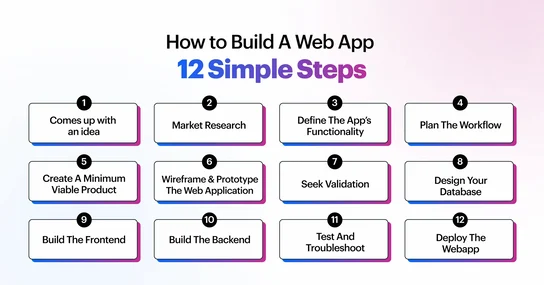Learn the basics of planning, building, and deploying your first web application from scratch—no prior experience required.
🧭 Step 1: Understand What a Web App Is
A web app is a software application that runs in a web browser. Unlike static websites, web apps are dynamic—they process data and interact with users.
Examples:
-
Social media platforms
-
Online stores
-
Blog platforms
-
Task managers
🧱 Step 2: Plan Your Web App
Before you write code, ask:
-
What problem will it solve?
-
Who are the users?
-
What are the key features?
-
Will it need user accounts or databases?
✅ Tip: Start simple. A to-do list, blog, or contact manager is perfect for your first app.
🛠️ Step 3: Choose Your Tech Stack
A basic web app includes:
-
Frontend (what users see): HTML, CSS, JavaScript
-
Backend (logic & database): Node.js, PHP, or Python
-
Database: MySQL, MongoDB, or PostgreSQL
Beginner Stack Suggestion:
-
HTML + CSS + JavaScript
-
PHP + MySQL
-
Apache or Nginx web server
Or go modern with:
-
Frontend: React.js
-
Backend: Node.js + Express
-
Database: MongoDB
🧑💻 Step 4: Set Up Your Development Environment
Install these tools:
-
Code Editor: VS Code
-
Local Server: XAMPP (for PHP) or Node.js
-
Database Tool: phpMyAdmin or MongoDB Compass
-
Git: For version control
💻 Step 5: Start Building Your App
-
Design the interface with HTML/CSS
-
Add interactivity using JavaScript
-
Connect to the backend (e.g., form submission, authentication)
-
Store data using a database (e.g., save form data)
Example file structure:
🧪 Step 6: Test Your App
-
Test all inputs, buttons, and links
-
Try to break it—what happens if fields are left blank?
-
Use browser developer tools (Inspect, Console)
🚀 Step 7: Deploy Your Web App
Options:
-
Shared Hosting: Upload via cPanel (e.g., Hostinger, Bluehost)
-
Cloud VPS: Use services like DigitalOcean, Linode, or Contabo
-
Platform-as-a-Service (PaaS): Netlify (frontend), Vercel, or Heroku
🔒 Step 8: Secure and Maintain
-
Use HTTPS (SSL certificates)
-
Validate user inputs
-
Back up your database
-
Keep dependencies updated
🧠 Bonus Tips
-
Use Git to track changes
-
Document your code and logic
-
Join developer communities for help
-
Build and break things—learning by doing is key!
✅ Final Thoughts
Building your first web app might seem daunting, but it's a step-by-step process. Don’t aim for perfection—focus on progress. Duck Cloud is here to guide you at every stage of your journey.
📚 Related Tutorials




Leave a Reply